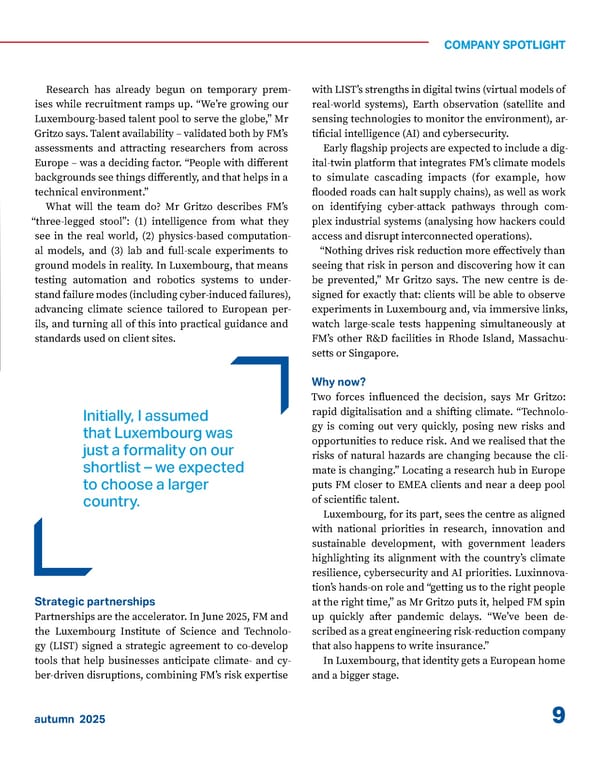9 autumn 2025 Research has already begun on temporary prem- ises while recruitment ramps up. “We’re growing our Luxembourg-based talent pool to serve the globe,” Mr Gritzo says. Talent availability – validated both by FM’s assessments and attracting researchers from across Europe – was a deciding factor. “People with different backgrounds see things differently, and that helps in a technical environment.” What will the team do? Mr Gritzo describes FM’s “three-legged stool”: (1) intelligence from what they see in the real world, (2) physics-based computation- al models, and (3) lab and full-scale experiments to ground models in reality. In Luxembourg, that means testing automation and robotics systems to under- stand failure modes (including cyber-induced failures), advancing climate science tailored to European per- ils, and turning all of this into practical guidance and standards used on client sites. Strategic partnerships Partnerships are the accelerator. In June 2025, FM and the Luxembourg Institute of Science and Technolo- gy (LIST) signed a strategic agreement to co-develop tools that help businesses anticipate climate- and cy- ber-driven disruptions, combining FM’s risk expertise with LIST’s strengths in digital twins (virtual models of real-world systems), Earth observation (satellite and sensing technologies to monitor the environment), ar- tificial intelligence (AI) and cybersecurity. Early flagship projects are expected to include a dig- ital-twin platform that integrates FM’s climate models to simulate cascading impacts (for example, how flooded roads can halt supply chains), as well as work on identifying cyber-attack pathways through com- plex industrial systems (analysing how hackers could access and disrupt interconnected operations). “Nothing drives risk reduction more effectively than seeing that risk in person and discovering how it can be prevented,” Mr Gritzo says. The new centre is de- signed for exactly that: clients will be able to observe experiments in Luxembourg and, via immersive links, watch large-scale tests happening simultaneously at FM’s other R&D facilities in Rhode Island, Massachu- setts or Singapore. Why now? Two forces influenced the decision, says Mr Gritzo: rapid digitalisation and a shifting climate. “Technolo- gy is coming out very quickly, posing new risks and opportunities to reduce risk. And we realised that the risks of natural hazards are changing because the cli- mate is changing.” Locating a research hub in Europe puts FM closer to EMEA clients and near a deep pool of scientific talent. Luxembourg, for its part, sees the centre as aligned with national priorities in research, innovation and sustainable development, with government leaders highlighting its alignment with the country’s climate resilience, cybersecurity and AI priorities. Luxinnova- tion’s hands-on role and “getting us to the right people at the right time,” as Mr Gritzo puts it, helped FM spin up quickly after pandemic delays. “We’ve been de- scribed as a great engineering risk-reduction company that also happens to write insurance.” In Luxembourg, that identity gets a European home and a bigger stage. COMPANY SPOTLIGHT Initially, I assumed that Luxembourg was just a formality on our shortlist – we expected to choose a larger country.
 Crossroads: Data, AI & Quantum - Reshaping the Global Economy Page 8 Page 10
Crossroads: Data, AI & Quantum - Reshaping the Global Economy Page 8 Page 10